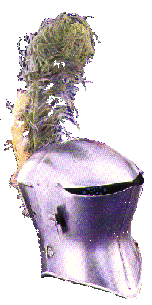|
|
|

|
|
|
|
|
|
|
HELMETS AND SHIELDS Helmets underwent radical changes in design throughout the Medieval Ages. From protective head coverings to outright fashion statements of the times, helmets ranged in diversity according to region, materials of craftsmanship, personal taste and sometimes were even dictated in style by campaign as in the Crusades.
Helmets were normally elaborate when constructed specifically for parades or tournaments. For field combat though it was necessary that the helmet provided decent peripheral vision, comfort and above all else, maximum protection. The Norman, Anglo-Saxon and Roman creations were mainly "open-faced" helmets. But when knights and soldiers began suffering an abundance of facial wounds, blindings and other injuries, the "Close Helmet" became popular. These pieces of headgear contained a visor that could be raised and lowered. Shileds always served one primary purpose. They were made to act as a buffer between combatants. Though style and decorations changed they were usually round, oval, square or triangular. The very first shields were made from tortoise shells in primitive times but as the ages progressed they were eventually crafted from wood, copper, bronze, iron and steel. In the Medieval Ages, since many knights and fighters combined pieces of armor, there was no clear way to distinguish friend from enemy on a battlefield. Thus the painting of "crests" became a popular idea. Crests either symbolized the family to which someone belonged or an emblem or insignia on the shield represented the appropriate king or lord being served in battle. Thus when the friendly emblem was recognized, a knight knew who was his friend in battle. |
|
|
|

|
|
|
|
|
|
|
|

